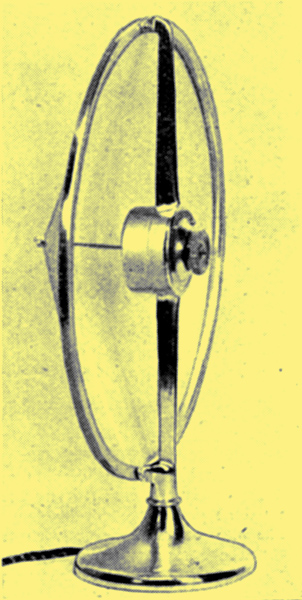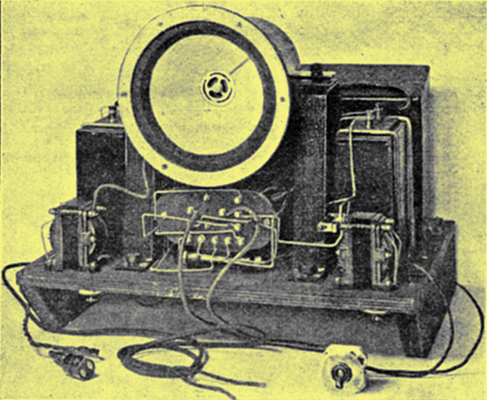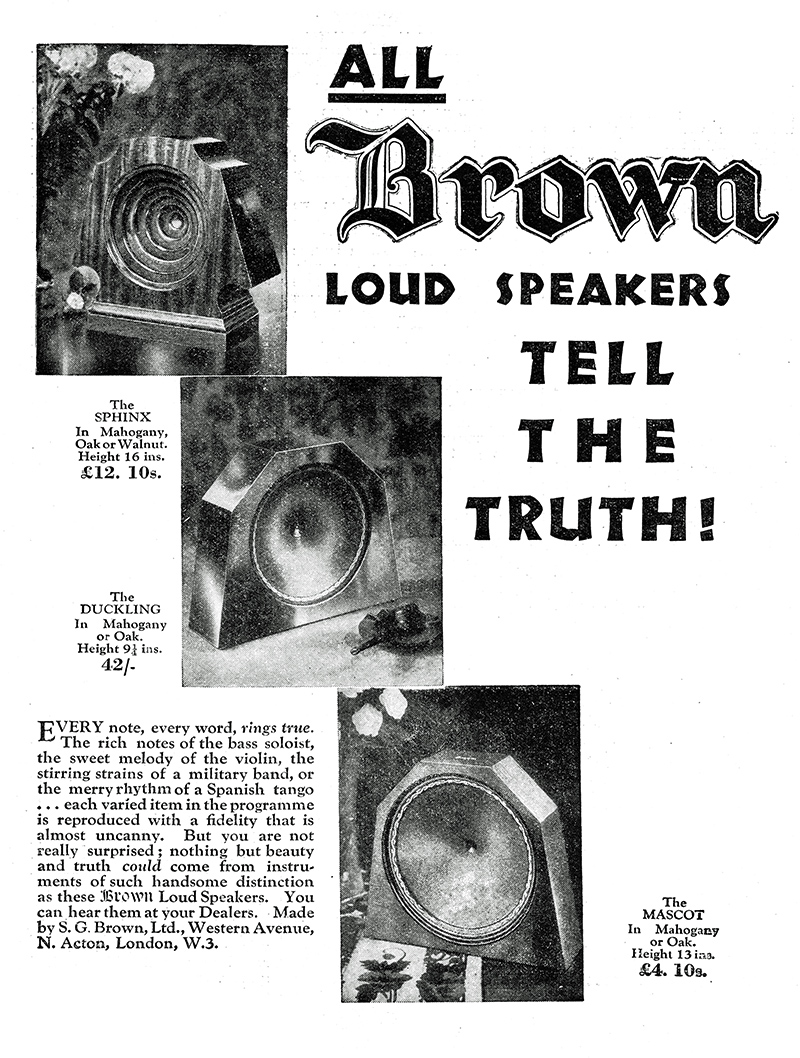|

No horn need be employed where the loud-speakers diaphragm is really large.
Widespread interest has been aroused in Wireless circles generally as the result of recent litigation between the Lektophone Corporation of Jersey City, USA, and Messrs Brown, Ltd, to decide the question of patent royalties payable on the use of cone loud speakers.
Dr Eccles Evidence
Plaintiffs claimed that their Hopkins patent covered any sound-reproducing machine using a large conical diaphragm freely exposed to the air and having an annular portion rigidly supported around its outer edges.
The Defendants (Messrs Brown) denied infringement, and counter-claimed for revocation of the patent on the ground that it was invalid for lack of novelty, subject-matter and sufficiency of description.
Dr WH Eccles, FRS, President of the Physical Society, and past President of the Institution of Electrical Engineers, was the principal witness for the Plaintiffs. The importance attached to the action may be estimated from the fact that Dr Eccles was in the box for five days. He said that small discs had previously been used in combination with a horn for reproducing sounds. A small disc without a horn would not respond efficiently to low notes. In such circumstances, it vibrated to and fro, the air could move easily from back to front and from front to back.
This led to the formation of air currents or eddies and represented so much waste of useful energy. By adding a horn the energy was concentrated and spread gradually outwards along the sides oi the horn until it reached the open end, where it entered the air and was radiated without perceptible loss.
Common Knowledge
There had been a good deal of investigation as to which was the best form in which to make the horn. Exponential or 'compound interest' horns were a favoured type at the present time.
The principal object of the Hopkins patent was to make a sound reproducer that would operate without a horn and yet give a large volume of sound as faithfully as possible throughout the entire musical range.
Asked how long it had been common knowledge that if no horn were used it was necessary to employ a larger diaphragm, Dr Eccles said: 'I dont know that it has been common knowledge at any stage'.
'Is it common knowledge now?'
'Yes, since the development of the cone loud speaker'.
'When do you place the coming in of the cone loud speaker?'
'With the introduction of Hopkins invention'.
'Was it not perfectly well known that in order to avoid local vibrations and to get movement as a whole the diaphragm must be made stiff'.
'It would be well known that to make the diaphragm move as a whole it must be made stiff'.
'The device of getting stiffness by 'coning has been suggested by a great many other people?'
'It has been used by many people'.
Licensees and Sales
The Assistant Secretary of Standard Telephones and Cables, Ltd, giving evidence, stated that his Company had made an arrangement with the Plaintiff Corporation for mutual dealing with patents. The Standard Telephones & Cables, Ltd, granted licences under certain patents jointly with the Lektophone Corporation.
He gave the following figures as to sales by licensees: Graham Amplion Co, for 1927, 43,108; for nine months in 1928, 26,342. General Electric Co, for 1927, 5,450; for nine months in 1928, 7,866. Celestion Company, from July, 1927, to July, 1928, 9,432.
Case for the Defence
In presenting the case for the Defendants, Counsel said that it had been suggested that Hopkins patent had had a great commercial vogue. In fact, the patent was first dug up in this country about 1927 and had never been heard of before here.
A large diaphragm was practically useless unless employed in combination with thermionic valve amplifiers capable of feeding it with considerable power. The demand for a large disc or cone loud speaker only arose after the introduction of broadcasting.
He submitted that the Hopkins patent merely applied to sound-reproducing machines of the gramophone type, where the operating impulses were derived from a stylus or needle following the grooves of a record. There were many material differences between such a machine and the modern loud speaker as used for broadcast reception.
In his view the Hopkins diaphragm had absolutely no basis to support the patent grant.
The use of diaphragms with a clamped edge was common knowledge. Practically all telephone instruments were constructed in this way-apart from the Brown reed type. Again, a 9-in. diaphragm was not a critical size for loud-speaker coils, nor was there any suggestion that Hopkins selected a particularly fine form of cone which gave out a particularly fine sound.
In short, the Hopkins specification did not disclose any profound acoustical knowledge. On the contrary, it merely set out a very precise form of construction which, he submitted, was shown by the evidence to be old.
Professor Swinburne on Broadcasting

The Rice-Kellogg moving-coil loud speaker, showing the complete mains-driven amplifier with which it is fitted. The cone diaphragm, is of what is referred to as the semi-free-edged diaphragm. However, legally, no doubt, it is 'clamped'.
Prof J Swinburne, FRS, giving evidence for the Defendant Company, said that the term 'loud speaker' only came into use since the introduction of the thermionic valve, which provided for the application of considerable energy from a local battery.
He thought that neither in gramophone nor in wireless reproduction were the high notes obtained properly even now. The whole of the transmission was distorted. The trouble began when the sound first entered the microphone, so that the blame was not always with the loud speaker.
For instance, the people at the broadcasting studios played all sorts of tricks. If a note was in the double bass and they thought it would not come out well enough, they made it an octave higher, and all that sort of thing.
In his view there was no novelty in what Hopkins claimed, viz, design, the use of a large diaphragm, and the elimination of the horn.
Judgment
In giving his considered judgment, Mr Justice Tomlin held that the Hopkins invention had been intended for use with a gramophone or similar stylus machine in which the sound vibrations were derived from a grooved record, and was not designed to be operated by the comparatively large power input derived from a valve amplifier as in modern broadcast reception.
He found that the Mascot loud speaker as sold by Messrs Brown did not in fact infringe the Hopkins patent. Judgment would accordingly be given for the Defendants on the main issue of infringement.
At the same time, he did not consider that the counter-claim for a revocation of the patent had been justified.

The disputed product was advertised in the same issue.
|